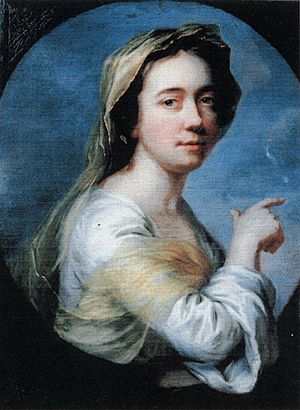Catherine Read facts for kids
Catherine Read was a talented Scottish artist who lived in the 1700s. She is best known for painting portraits of people. For many years, she was a popular artist in London, using oil paints, crayons, and tiny miniature paintings. From 1760, she often showed her artwork at big art exhibitions like the Incorporated Society of Artists and the Royal Academy. She mostly painted graceful and refined portraits of important ladies and children.
Contents
Early Life in Scotland
Catherine Read was born in Dundee, Scotland, on February 3, 1723. She was one of thirteen children in a wealthy family from Forfarshire. She learned art from Maurice Quentin de La Tour in Edinburgh. Her mother's brother, Sir John Wedderburn, 5th Baronet of Blackness, was involved in the Jacobite uprising of 1745. After he was executed, Catherine helped care for his daughters.
Art Studies in Paris and Rome
After the war ended at the Battle of Culloden, Catherine's family had to leave Scotland because they had supported the Jacobite cause through her uncle. In 1746, they found safety in Paris, France. There, they met the painter Robert Strange, who might have been Catherine's first teacher in France.
It was hard for women, especially foreigners whose families were in trouble with the British King, to join art academies. But Catherine still studied other artworks and improved her skills. In the late 1740s, she spent time in the studios of famous pastel artists like Maurice Quentin de La Tour and Louis Blanchet.
However, Catherine had to leave Paris in 1750, moving to Rome with many other Jacobite supporters. In Rome, she became friends with important members of the Roman Catholic Church. They often asked her to copy famous paintings using oil or pastel. One of her supporters, Cardinal Albani, even let her copy portraits he owned by Rosalba Carriera. Later, Cardinal Albani himself sat for a portrait by Catherine.
Successful Career and Royal Paintings

Catherine stayed in Rome until 1753, when she decided to move to England. Cardinal Albani helped her, so her family's past involvement in the war didn't cause her problems. In England, she quickly found many important clients. She painted for a distinguished group of people, including Queen Charlotte.
At the peak of her career, many of her paintings were made into prints. This helped her become even more famous and successful. Catherine also shared her methods for fixing pastels with the Society of Arts. However, her techniques were seen as less effective than those of another artist, Sebastien Jurine, because she used a different type of pastel.
In 1764, Catherine went back to Paris to paint portraits for Madame Elisabeth, a member of the French royal family. Her work was shown by the Free Society (from 1761 to 1768) and the Society of Artists (from 1760 to 1772). In 1769, she became an honorary member of the Society of Artists, along with two other female pastel artists, Mary Benwell and Mary Black. This happened after the Royal Academy accepted Angelica Kauffman and Mary Moser as members. Later, Catherine tried to join the Royal Academy herself. When she did, she was removed from the Society of Artists.
She lived in St. James's Place in London until 1766, when she moved to Jermyn Street.
Later Life and Passing
As new pastel artists became popular, Catherine Read's fame began to fade.
In 1771, she traveled to India to paint portraits of the English officers living there. Her niece, Helena Beatson, who was also a talented young artist, went with her. In 1777, Helena married Charles Oakeley, who later became the governor of Madras. Catherine was reported to be in India in 1775 and 1777. She passed away at sea near Madras on December 15, 1778.
Notable Artworks
In 1763, Catherine showed a portrait of Queen Charlotte with her baby, the Prince of Wales. In 1765, she exhibited another painting of the Prince of Wales with his brother, Prince Frederick.
After returning to her art practice, Catherine settled in Welbeck Street. Many of her portraits were beautifully engraved by artists like Valentine Green and James Watson. Two popular prints by J. Finlayson showed the famous Gunning sisters, the Duchess of Argyll and the Countess of Coventry.
Some of Catherine Read's paintings were once mistakenly thought to be by the famous artist Joshua Reynolds. Her portrait of Lady Georgiana Spencer is considered one of her best works.
Her Legacy
Catherine Read's skill in painting portraits was highly respected during her time. The writer Tobias Smollett even wrote a poem praising her:
Let candid Justice our attention lead,
to the soft crayon of the graceful Read.
The writer William Hayley also praised her work.
Catherine also helped many other female artists, like Caroline Watson, by giving them opportunities and support.


